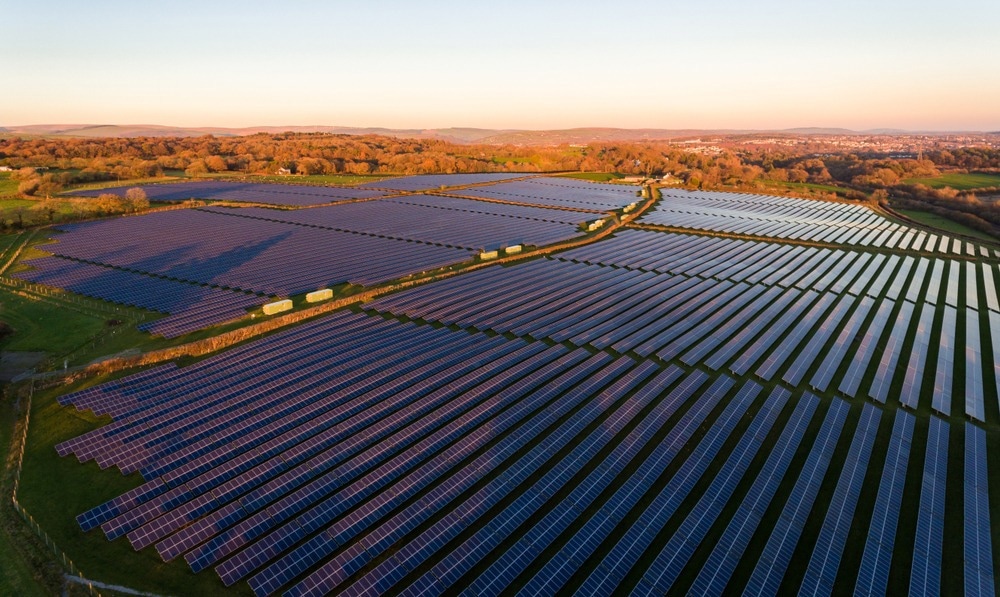Photodetectors are also known as photosensors that change light energy into electrical signals. For many years, scientists have envisioned developing novel detectors to develop superior solar cells. Recently, they have designed a photodetector inspired by plants’ photosynthetic complexes that convert sunlight into energy. This device is based on polariton propagation over long distances in an organic semiconductor thin film.

Image Credit: steved_np3/Shutterstock.com
Photosynthesis and Long-Distance Transfer of Energy
Photosynthesis is a complex physiological process that involves the absorption of solar photons by chromophores, which transforms the electrons of the pigment molecule from the ground state to an excited state.
The photosynthetic complexes of plants consist of large light absorbing regions whose prime function is to deliver energy from molecular excited states to the reaction center (RC), where the energy is converted to electrical energy.
Chromophore molecules are arranged in an extended antenna complex (AC) that ultimately transfers energy to an RC. Following the generation of excitons, i.e., electronically excited states, the RC separates the exciton into an electron and a hole. The free energy gets ultimately converted to chemical energy.
The excited energy in the photosynthetic complex is transferred via near-field Förster intermolecular hopping, which is highly precise due to the specific ordering of chromophore molecules.
Limitations of Conventional Photodetector Devices
The main limitation associated with artificial AC/RC systems is a material disorder that ceases electron transport after a few molecular hops. This shortcoming has been resolved by using customized molecular structure assemblies. Nevertheless, this device's inadequate exciton transport distances have limited its practical application.
The problems associated with enhancing long-range energy transport have been resolved by implementing molecular excitons patterns of photons in photonic structures, which form new quantum mechanical quasi-particles called exciton-polaritons.
The traditional polaritonic structures use planar microcavities, which utilize optically active layers buried between distributed Bragg reflectors (DBRs) or metallic mirrors. However, the relatively short life spans and low group velocities inhibit their electronic propagation over large distances.
Truncated all-dielectric photonic structures support energy propagation at high group velocities through non-dissipative Bloch surface waves (BSWs).
BSW polaritons are immune to interactions with local defects in molecular solids due to their small effective mass and inherent delocalization of photonic components. These structural features enable efficient, long-range, and high-speed energy transport. Therefore, polaritons have been identified as a possible route to mimic natural AC, without following precise chromophore arrangement to support energy transport and eliminate any energy loss.
How Did the Photosynthetic Complex Inspire the Development of the Novel Photodetector?
Compared to the conventional organic semiconductor solar cells arrangement, the photosynthetic complex has a superior AC/RC architecture, which enhances emission quantum efficiency of the charge transfer (CT) state at the donor-acceptor heterojunction (D-A HJ). Mimicking the mechanism of a photosynthetic complex in artificial devices is a difficult task because it requires achieving long-range energy transport in organic material.
Dr. Stephen Forrest of the University of Michigan, and the research team leader, stated that their device combined long-range transport of optical energy and long-range conversion to electrical current. The long-range polariton-mediated photodetection was demonstrated at room temperature.
The photodetector was designed by mimicking the photosynthetic process, i.e., via the combination of long-range energy transport of a strongly coupled organic exciton–BSW artificial AC and an organic D-A HJ RC. This system could effectively convert the polariton back into a CT exciton, which would be separated into an electron and a hole and ultimately detected in an external circuit.
Although this artificial AC/RC system is similar to a natural photosynthetic structure, it has some dissimilarities. For example, unlike the natural AC system, the energy transport in the artificial device is isotropic.
Characteristic Features of the Newly Developed Photodetector
The photodetector design has led to a significant enhancement in the power generation efficiency of solar cells. This photodetector is one of the first demonstrations of an optoelectronic device based on polaritons. The design has provided insights into how polaritons propagate in open structures with a single mirror.
This research has opened a new path to study further applications of polaritons.
This device was analyzed via a special Fourier plane microscope to evaluate polariton propagation. Owing to its unusual structure, the research team had to develop a new method to quantify its results accurately to be comparable to conventional detectors. Notably, the newly developed photodetector converted light to electric current more efficiently than silicon photodiodes.
The photodetector could collect light from areas around 0.01 mm2 and convert it to electrical energy over remarkable long distances of 0.1 nm. This distance is almost three times more than the energy transfer distance of the photosynthetic complex.
References and Further Reading
Liu, B. et al. (2022) Photocurrent generation following long range propagation of organic exciton-polaritons. Optica, 9(9). https://opg.optica.org/optica/fulltext.cfm?uri=optica-9-9-1029&id=497657
New photodetector design inspired by plant photosynthesis. (2022) [Online] Available at: https://www.optica.org/en-us/about/newsroom/news_releases/2022/september/new_photodetector_design_inspired_by_plant_photosy/
Photosynthesis copycat may improve solar cells. (2022) [Online] Available at: https://ece.engin.umich.edu/stories/photosynthesis-copycat-may-improve-solar-cells
Plant-Based Strategy for Harvesting Light. (2022) [Online] Available at: https://physics.aps.org/articles/v15/144
Disclaimer: The views expressed here are those of the author expressed in their private capacity and do not necessarily represent the views of AZoM.com Limited T/A AZoNetwork the owner and operator of this website. This disclaimer forms part of the Terms and conditions of use of this website.